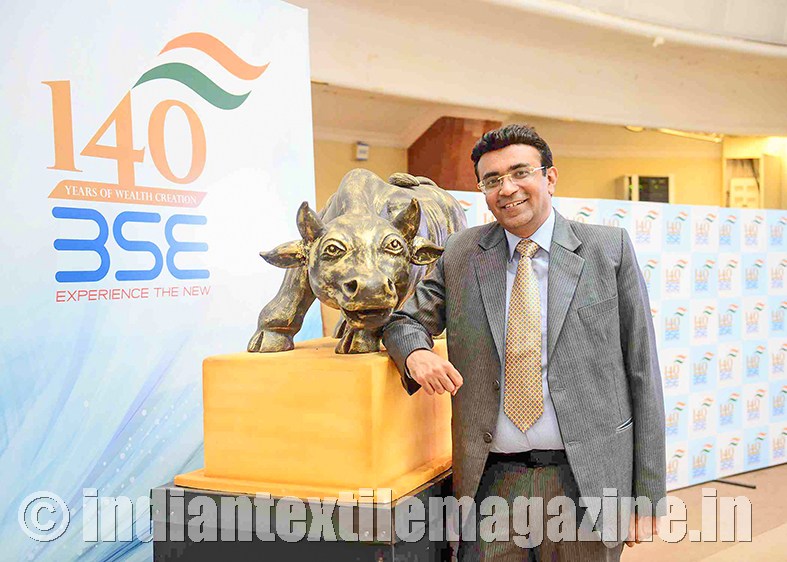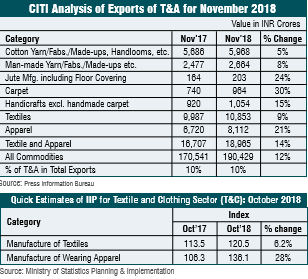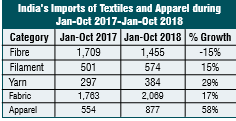Mr. Sanjay Jain, Chairman, Confederation of Indian Textile Industry (CITI), has welcomed the new scheme launched by the Gujarat Government for assistance to strengthen specific sectors in the textile value chain. He has thanked the State Government for being prudent and excluding ginning and spinning sectors as there is overcapacity and focusing on value-added segments where the country is weak, such as weaving, knitting, processing and technical textiles.

He has highlighted the fact that under the previous policy of the Gujarat Government, there has been a lot of investments in the spinning sector. However, the spinning capacity in India is already in excess with 30% exportable surplus, and there is no need for any further investment incentives for this sector. Further, with the excess capacity in spinning and removal of all export incentives, the sector is facing tremendous margin pressure and a lot of NPAs are happening in it.
With the host of incentives by the Government of Gujarat in the form of interest and power tariff subsidy, the new scheme will also provide assistance in a variety of areas such as technology upgradation and environmental compliance cost and for the textile parks.
This is also a welcome step for weaving, knitting, dyeing / printing, machine carpeting, technical textiles, made-ups, composite units and other activities in the textile value chain. It will ensure balanced growth for the Indian textile industry as a whole and would further ensure that subsidies are given to the needed sectors only.
Mr. Jain has appealed to the other State Governments to take cue from the Centre and the Gujarat Governments and ensure that it may not subsidise sectors where the country is already surplus on capacity. He also stated that there is a need to have a country-focused approach as against the State-level policies, which is leading to tax-payers hard earned money being used where it is not required at all, and less money is getting allocated to the deficit sectors. Hence, the States need to be prudent in incentivising investments by focusing on thrust areas where they have a dearth of policy support.
Govt. move to further promote technical textiles hailed
Mr. Sanjay Jain, CITI Chairman, has thanked the Government for notifying 207 HSN Codes as technical textiles. A long-standing demand by the industry, this step will give a major boost to the technical textiles, now considered a sunrise sector.
Mr. Sanjay Jain pointed out that technical textiles provide new opportunities to the Indian textile industry to have long-term sustainable future. They are not limited to chapters 50 to 63 of HSN Codes pertaining to conventional textiles, but are covered under the HSN Codes spread over Chapter 1 to 99. In order to compile the data on export and import and also provide fiscal support, it was necessary to identify the HSN Codes of all the technical textile items.
He has further stated that the absence of clear classification of technical textiles was creating confusion, and many genuine manufacturers were not getting the various incentives and subsidies being allowed to technical textiles. This was impacting investment in this fast-growing sunrise segment. Now the policy intervention will help the industry to invest increasingly in this segment and facilitate the growth of the Indian textile industry as a whole.
According to him, technical textiles are vital for the overall growth of the textile industry as they are value-added products manufactured primarily for technical performance and multi-functional properties with less intent on aesthetics & design. The diverse range of technical textiles in India can be broadly grouped into 12 categories, such as Agrotech, Meditech, Packtech, Clothtech, Indutech, Hometech, Geotech, Oekotech, Protech, Sportstech, Buildtech and Mobitech. All of them are expected to register a double-digit growth.
As per the latest survey by the Ministry of Textiles, the technical textiles industry in the country was estimated at Rs. 1,16,217 crores in 2017-18. This is likely to reach at Rs. 2,00,823 crores by 2020-21 with a CAGR of 20%. Demand for this sector is rising due to many factors, including rapid urbanization, advances in medical technology, expansion in the construction sector, awareness on safety and environmentalism and increased dependence on healthcare.
However, Mr. Jain said that India still has a long way to go as it currently lacks the ability to meet the rising demand and to be globally competitive. There is untapped potential both in exports and the domestic market for technical textiles. In order to make the industry globally competitive, a dual policy needs to be adopted for export and the domestic market.
A proactive approach from the Government as well as the industry stakeholders will be the key for Indian technical textiles to realize its full potential. One of the key steps that may be taken by the Government is to set regulatory norms for mandatory usage of technical textile items in specific industries to increase overall consumption. Apart from that, focus on bringing foreign direct investment in order to get the requisite technical know-how and expertise would be crucial.
CITI happy over Govt. policy changes to improve textile sector prospects
Mr. Sanjay Jain, CITI Chairman, has stated that as per the RBI Financial Stability Report – December 2018, the stressed advance ratio of the textile sub-sector has been steadily improving. From 23.70% in September 2017, it has come down to 18.70% in September 2018. Further, as per the Ministry of Commerce & Industry, textile and apparel exports stood at Rs. 18,965 crores during November 2018 as compared to Rs. 16,707 crores during November 2017, showing an impressive growth of 14%. It is noteworthy that over the same period apparel exports have grown at a remarkable rate of 21%.
The CITI Chairman is delighted to see the positive IIP data. It is pertinent to mention here that the IIP production data for T&C also witnessed robust growth during October 2018 as compared to October 2017. Textiles and apparel have registered a growth of 6.2% and 28% respectively during October 2018.
According to Mr. Jain, the positive trend in the entire textile value chain has been the result of the pragmatic approach of the Union Ministers of Finance, Commerce & Industry and of Textiles. The support extended by the Government to the industry includes disbursement of Rs. 1,300 crores for the Samarth Scheme, Rs. 6,000 crores for the apparel & made-ups package along with various State incentives, resolution of GST-related issues, increase in import duty of various textile and apparel items, etc.
Apart from the above, some of the other prominent schemes that the Ministry of Textiles has introduced for the development of the entire textile value chain are the Scheme for Integrated Textile Park (SITP) and the Integrated Processing Development Scheme (IPDS) which have been extended and notified for the period from 2017 to 2020, and the Technology Upgradation Fund Scheme (TUFS) under which A-TUFS has been launched for 2016-2022.
However, Mr. Jain has pointed out that one major area of worry for the T&C industry today is the steadily rising imports of textile products. As indicated in the table below, all the categories across the value chain have seen a drastic rise in imports during January-October 2018 against the same period the previous year.

